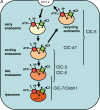Chloride and the endosomal-lysosomal pathway: emerging roles of CLC chloride transporters
- PMID: 17110406
- PMCID: PMC2151350
- DOI: 10.1113/jphysiol.2006.124719
Chloride and the endosomal-lysosomal pathway: emerging roles of CLC chloride transporters
Abstract
Several members of the CLC family of Cl- channels and transporters are expressed in vesicles of the endocytotic-lysosomal pathway, all of which are acidified by V-type proton pumps. These CLC proteins are thought to facilitate vesicular acidification by neutralizing the electric current of the H+-ATPase. Indeed, the disruption of ClC-5 impaired the acidification of endosomes, and the knock-out (KO) of ClC-3 that of endosomes and synaptic vesicles. KO mice are available for all vesicular CLCs (ClC-3 to ClC-7), and ClC-5 and ClC-7, as well as its beta-subunit Ostm1, are mutated in human disease. The associated mouse and human pathologies, ranging from impaired endocytosis and nephrolithiasis (ClC-5) to neurodegeneration (ClC-3), lysosomal storage disease (ClC-6, ClC-7/Ostm1) and osteopetrosis (ClC-7/Ostm1), were crucial in identifying the physiological roles of vesicular CLCs. Whereas the intracellular localization of ClC-6 and ClC-7/Ostm1 precluded biophysical studies, the partial expression of ClC-4 and -5 at the cell surface allowed the detection of strongly outwardly rectifying currents that depended on anions and pH. Surprisingly, ClC-4 and ClC-5 (and probably ClC-3) do not function as Cl- channels, but rather as electrogenic Cl--H+ exchangers. This hints at an important role for luminal chloride in the endosomal-lysosomal system.
Figures





Similar articles
-
Cell biology and physiology of CLC chloride channels and transporters.Compr Physiol. 2012 Jul;2(3):1701-44. doi: 10.1002/cphy.c110038. Compr Physiol. 2012. PMID: 23723021 Review.
-
Voltage-dependent electrogenic chloride/proton exchange by endosomal CLC proteins.Nature. 2005 Jul 21;436(7049):424-7. doi: 10.1038/nature03860. Nature. 2005. PMID: 16034422
-
Distinct ClC-6 and ClC-7 Cl- sensitivities provide insight into ClC-7's role in lysosomal Cl- homeostasis.J Physiol. 2023 Dec;601(24):5635-5653. doi: 10.1113/JP285431. Epub 2023 Nov 8. J Physiol. 2023. PMID: 37937509 Free PMC article.
-
CLC chloride channels and transporters: from genes to protein structure, pathology and physiology.Crit Rev Biochem Mol Biol. 2008 Jan-Feb;43(1):3-36. doi: 10.1080/10409230701829110. Crit Rev Biochem Mol Biol. 2008. PMID: 18307107 Review.
-
Physiological roles of CLC Cl(-)/H (+) exchangers in renal proximal tubules.Pflugers Arch. 2009 May;458(1):23-37. doi: 10.1007/s00424-008-0597-z. Epub 2008 Oct 14. Pflugers Arch. 2009. PMID: 18853181 Review.
Cited by
-
Ion Channels in Glioma Malignancy.Rev Physiol Biochem Pharmacol. 2021;181:223-267. doi: 10.1007/112_2020_44. Rev Physiol Biochem Pharmacol. 2021. PMID: 32930879 Review.
-
Census of halide-binding sites in protein structures.Bioinformatics. 2020 May 1;36(10):3064-3071. doi: 10.1093/bioinformatics/btaa079. Bioinformatics. 2020. PMID: 32022861 Free PMC article.
-
Uncoupling endosomal CLC chloride/proton exchange causes severe neurodegeneration.EMBO J. 2020 May 4;39(9):e103358. doi: 10.15252/embj.2019103358. Epub 2020 Mar 2. EMBO J. 2020. PMID: 32118314 Free PMC article.
-
Evolutionary rate covariation identifies SLC30A9 (ZnT9) as a mitochondrial zinc transporter.Biochem J. 2021 Sep 17;478(17):3205-3220. doi: 10.1042/BCJ20210342. Biochem J. 2021. PMID: 34397090 Free PMC article.
-
Elasticity in Macrophage-Synthesized Biocrystals.Angew Chem Int Ed Engl. 2017 Feb 6;56(7):1815-1819. doi: 10.1002/anie.201611195. Epub 2017 Jan 12. Angew Chem Int Ed Engl. 2017. PMID: 28079296 Free PMC article.
References
-
- Accardi A, Miller C. Secondary active transport mediated by a prokaryotic homologue of ClC Cl− channels. Nature. 2004;427:803–807. - PubMed
-
- Chalhoub N, Benachenhou N, Rajapurohitam V, Pata M, Ferron M, Frattini A, Villa A, Vacher J. Grey-lethal mutation induces severe malignant autosomal recessive osteopetrosis in mouse and human. Nat Med. 2003;9:399–406. - PubMed
-
- Cleiren E, Benichou O, Van Hul E, Gram J, Bollerslev J, Singer FR, Beaverson K, Aledo A, Whyte MP, Yoneyama T, deVernejoul MC, Van Hul W. Albers-Schönberg disease (autosomal dominant osteopetrosis, type II) results from mutations in the ClCN7 chloride channel gene. Hum Mol Genet. 2001;10:2861–2867. - PubMed
-
- De Angeli A, Monachello D, Ephritikhine G, Frachisse JM, Thomine S, Gambale F, Barbier-Brygoo H. The nitrate/proton antiporter AtCLCa mediates nitrate accumulation in plant vacuoles. Nature. 2006;442:939–942. - PubMed
Publication types
MeSH terms
Substances
LinkOut - more resources
Full Text Sources
Other Literature Sources
Molecular Biology Databases
Research Materials

